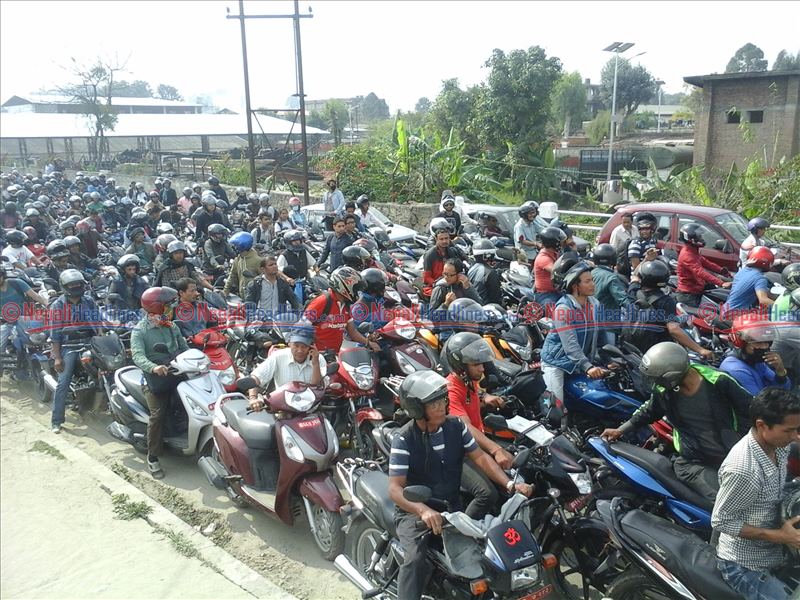Pritam Bhattarai
Kathmandu: It’s been almost two months that a memorandum of understanding (MoU) was signed between the Nepal Oil Corporation (NOC) and China National United Oil Corporation (PetroChina) to supply petroleum products to Nepal. This was a late but inevitable step taken by the country to diversify fuel trade and end the four-decade fuel supply monopoly of the Indian Oil Corporation.
Besides, the historic agreement signed between the two countries in Beijing on October 28 had also given a sense of relief to the Nepali people, reeling from an acute shortage of fuel, following India’s embargo.
However, the fuel trade agreement between Nepal and China is yet to be materialized. Nepal can only begin to import fuel from China after both NOC and PetroChina strike a commercial agreement for the same.
Following the historic agreement, officials of the Ministry of Commerce and Supplies (MoCS) and NOC reached China three times to conduct a technical survey on the possibility of oil trade from China, including the recent one but without yielding any good results. This has put the commercial deal with China to import petroleum products into uncertainty.
Preparation of a modality is required on the required quantity, transportation route, quality and pricing before signing the deal.
Ignorant expressed by concerned authorities about when the deal would be struck has also cast a sense of uncertainty. MoCS spokesperson Shambhu Ghimire said that he was not aware about when the deal would be signed and why it got delayed. He said that it is a government-to-government deal between Nepal and China.
This indicates that weak initiatives taken by the government in this regard have resulted in the delay, involving the failure of concerned authorities to pay seriousness and urgency in this regard. Instead, the government is seeking other alternatives to import fuel to address the shortage in the short-term.
Recently, the government of Nepal requested the government of Saudi Arabia for grant assistance of 20,000 kiloliters of gasoline in an attempt to address the fuel shortage in Nepal.
As per the request of the MoCS, the Ministry of Foreign Affairs wrote recently to the Saudi government, seeking 10,000 kiloliters petrol and a similar quantity of diesel at subsidised rate.
The amounts of petroleum products Nepal government has sought from Saudi government would serve only for a short term to Nepalis reeling under acute shortage of fuel. Nepal had received a similar grant of fuel from China before deliberations began for a long-term import.
Unlike in previous embargo imposed by India in 1989, China has expressed its readiness to trade fuel with Nepal this time around. Providing 1.3 million liters gasoline to Nepal on grant right after the signing of MoU is testimony to this. However, some difficulties lie in the process as this is the first time that MoU was signed between Nepal and China to supply petroleum products to Nepal. On part of China, it is much concerned over whether the oil trade with Nepal would remain long-lasting, apart from some of them being quality of oil, pricing and transportation among others.
On top of that, China wants to enter into a fuel trade agreement without hurting its largest trading partner India. Right after India’s concern over China’s decision to provide Nepal with 1.3 liters petroleum products on grant, Chinese officials asserted that the decision taken by Chinese government to provide gasoline to Nepal on grant was only as immediate relief. It means that China does not want to hurt its biggest trading partner India when it comes to any trade deal with Nepal.
According to available reports, the bilateral trade between India and China has a potential worth over USD 80 billion in 2015 from USD 70 billion in 2014, the amounts far bigger when it comes to trade transaction between Nepal and China.
As a result, it requires greater resolve and initiative on part of Nepali authorities and leaders to materialise the concept of importing fuel from China by inking a commercial agreement between the two countries at the earliest. Nepal should also make it clear to its longtime trading partner India that it is just trying to diversify its trade and not stopping trading with India.
India too needs to understand that the long-term interest of its immediate and age-old neighbour is in diversifying its trade not only with China but also with other possible destinations in the region, including Bangladesh, Pakistan and Sri Lanka.






